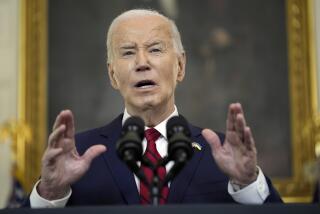Reagan to Put Off ABM Pact Ruling : Move Would Delay New Interpretation That Would Speed ‘Star Wars’ Testing
- Share via
WASHINGTON — President Reagan will postpone indefinitely a decision on the Pentagon’s recommendation that he adopt a broader interpretation of the 1972 anti-ballistic missile treaty to allow for accelerated testing of a space-based missile defense system, Administration and congressional sources said Friday.
Reagan is understood to agree with Administration officials who advocate a delay in the decision until State Department officials have had an opportunity to complete another study on the legal issues involved in altering the current U.S. view of the treaty.
Such a delay would be a victory for Secretary of State George P. Shultz, who has warned the President that members of Congress and allied leaders would be angered by any abrupt change in the Administration’s treaty interpretation. Shultz has argued that the President should not act until U.S. officials have consulted with U.S. allies and congressional leaders.
Confrontation Avoided
On Friday, Sen. Sam Nunn (D-Ga.), chairman of the Senate Armed Services Committee, told Reagan in a letter that an abrupt change in the U.S. definition of the treaty “would provoke a constitutional confrontation of profound dimensions” between Congress and the White House. He predicted that Congress would respond by making deep cuts in funding for the missile defense system, known as the Strategic Defense Initiative or “Star Wars.”
Yet Defense Secretary Caspar W. Weinberger continues to press for a broader interpretation of the ABM treaty, and sources said that the President probably will be forced to accept the Pentagon’s recommendation in the future. “Pressure from the right wing will eventually push them into it,” one knowledgeable Capitol Hill source said.
Conservatives are anxious for the Administration to adopt a strategy for deploying an early version of the space-based defense system by the mid-1990s. But such a strategy would require testing of some systems that would violate the United States’ current narrow interpretation of the ABM treaty.
The ABM treaty, which was ratified by the Senate and remains in effect, forbids national anti-missile networks, allowing only 100 ABM missiles on each side and restricting further missile defenses to research.
However, the treaty does not contain specific provisions that apply to technology developed on the basis of “other physical principles,” saying only that such systems would be “subject to discussion.”
Pressure for Concessions
In recommending adoption of the broader definition, Weinberger was seen as bowing to these conservatives and bringing new pressure on the Soviet Union to make concessions in arms control negotiations in Geneva.
The broader interpretation, which would permit SDI testing of the type advocated by some conservatives, was not embraced by the President in 1985 when it was first advanced. Since then, however, Reagan has expressed support for this definition, which resulted from an Administration review of the highly classified negotiating record of the treaty.
The President, who discussed the issues of SDI deployment and the ABM treaty with his top national security advisers earlier this week, is scheduled to chair another meeting on the subject Tuesday. Although conservatives still hope to reverse the President’s preliminary decision for postponement, sources said that he is not likely to adopt the broader interpretation until the State Department’s study has been completed.
The study by Abraham D. Sofaer, the State Department’s legal adviser and an early proponent of the broader definition, is viewed by members of Congress as a stalling tactic by Shultz. State Department sources said that Sofaer’s study will take at least five or six months, even though supporters of the Pentagon’s recommendation, such as Atty. Gen. Edwin Meese III, are known to be pressing for a swifter review that would be completed within a month.
“A study like that can take forever, if you want it to,” said a source familiar with Shultz’s view of the matter.
Sources said Shultz has argued that the President should not make a decision on the ABM issue until “Star Wars” research is actually being stymied by the narrower interpretation of the treaty. The question to be answered at Tuesday’s meeting with the President is at what point the narrow interpretation will begin to restrain SDI research.
A Sense of Urgency
In testimony before the House Budget Committee earlier this week, Weinberger said he hopes that the United States could begin deployment of an early version of the “Star Wars” system by 1994. “If we’re going to do that, we have to start making some decisions fairly soon,” he said.
But Shultz told the Armed Services Committee last Tuesday that he saw no need for the Administration to make any decisions on SDI deployment this year, even though the research is progressing faster than previously expected.
Although it was a study of the ABM negotiating record by Sofaer that originally produced the broader interpretation of the treaty, sources said that his current review will go beyond the negotiating record to consider what the Senate was told at the time of ratification, as well as what the practice has been since then.
Sources familiar with the review said the record shows that Administration officials made statements to the Senate at the time of ratification that do not support the broader definition.
Independent Review
In his letter to the President, Nunn said his staff is completing its own, independent review of the negotiating record, which was supplied to the Senate last year by the White House. The senator said he hopes that Reagan will make no decision until the results of the staff study are available to the White House.
White House officials said they expect Nunn’s review to support the narrower interpretation, and they indicated that the President will take the senator’s views into consideration.
“I am concerned that, absent due consultation, a unilateral executive branch decision to disregard the interpretation of the treaty, which the Senate believed it had approved when the accord was ratified in 1972, would provoke a constitutional confrontation of profound dimensions,” Nunn said.
He added that such a decision would have “several extremely adverse consequences,” both in Congress and among members of the North Atlantic Treaty Organization. “Such a decision would also very likely be taken on Capitol Hill as the end of arms control under your Administration--whether accurate or not,” Nunn told Reagan in his letter.
Compound Growing Anger
Rep. Norman D. Dicks (D-Wash.), a leading arms control advocate in Congress, said that a decision to move to the broader interpretation of the ABM treaty would only compound growing anger among congressional arms control advocates. These supporters are already upset by Reagan’s decision to break the limits of the unratified 1979 strategic arms limitation treaty and his opposition to a nuclear test ban, Dicks said.
“The Administration is going to run into a real hailstorm up here,” he said.
Dicks predicted that Congress would retaliate by denying the President funding for any testing of SDI systems that violates the narrow interpretation of the ABM treaty.
At the same time, sources said the President eventually may be forced to adopt the broader interpretation as an alternative to a proposal being put forth by some conservatives in Congress for early deployment of a ground-based defensive system that would not violate the narrow interpretation of the ABM treaty.
More to Read
Sign up for Essential California
The most important California stories and recommendations in your inbox every morning.
You may occasionally receive promotional content from the Los Angeles Times.













